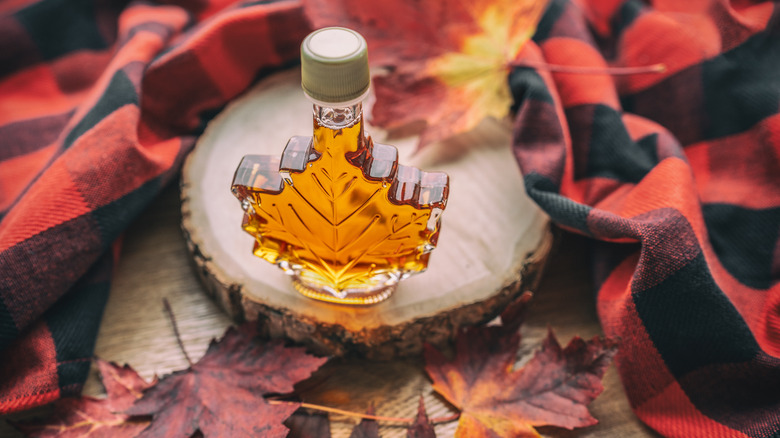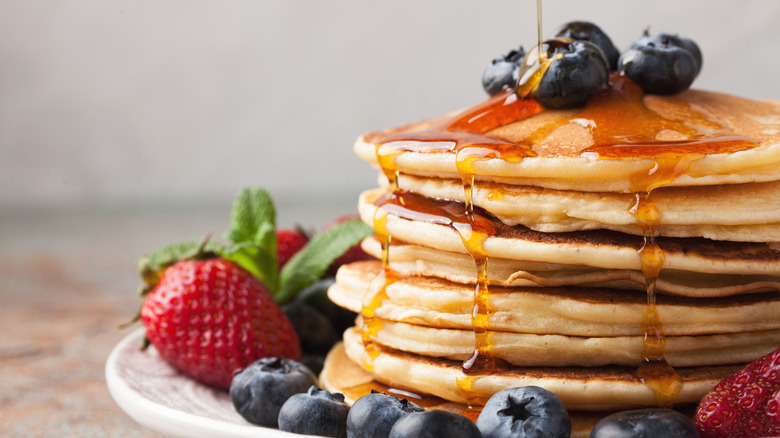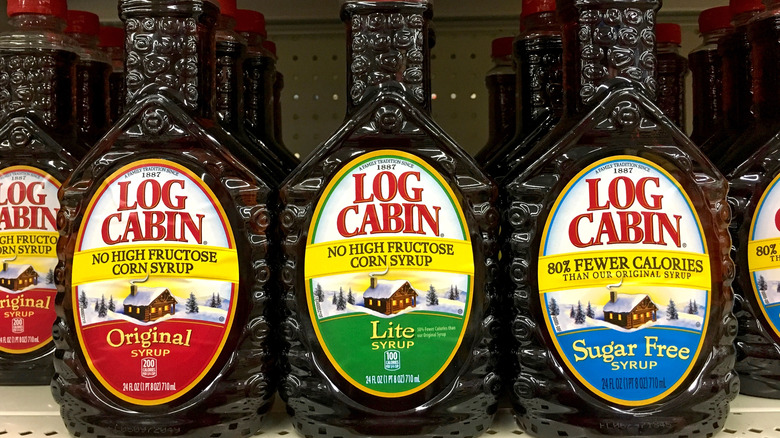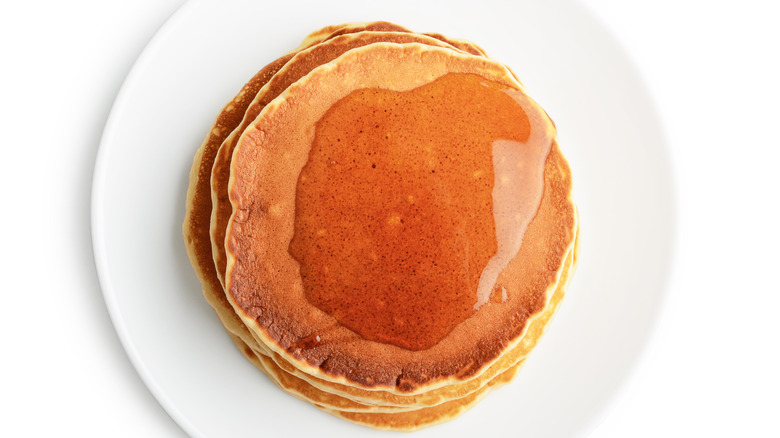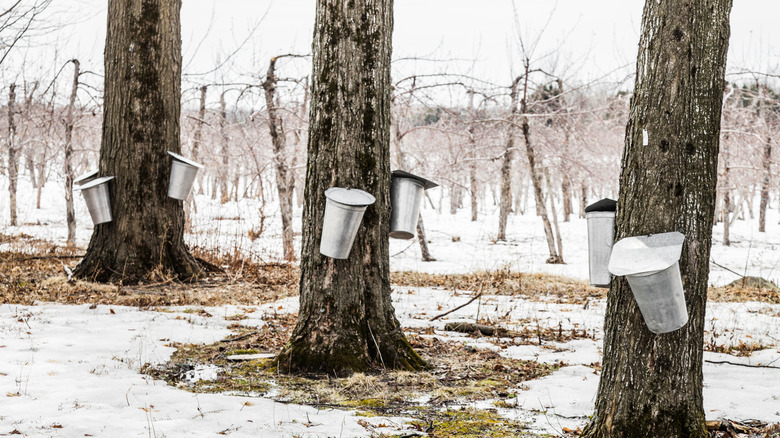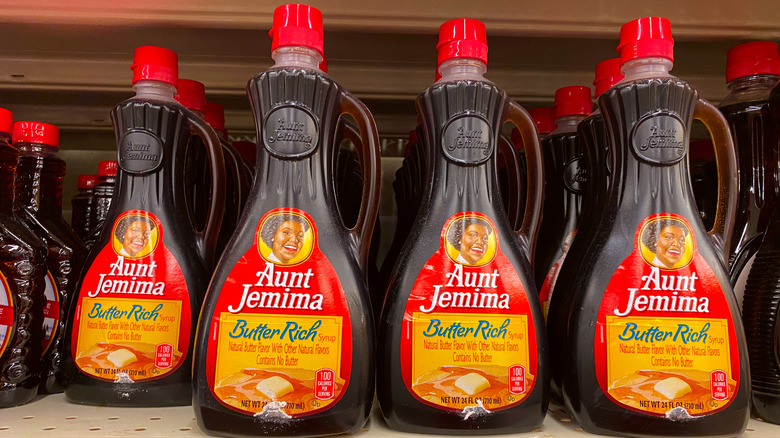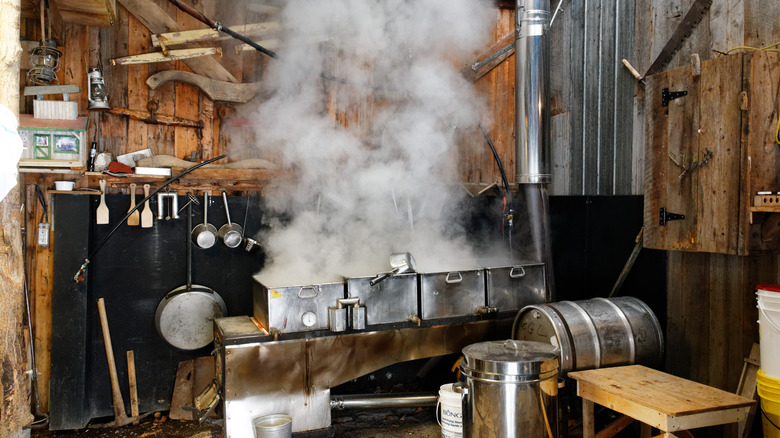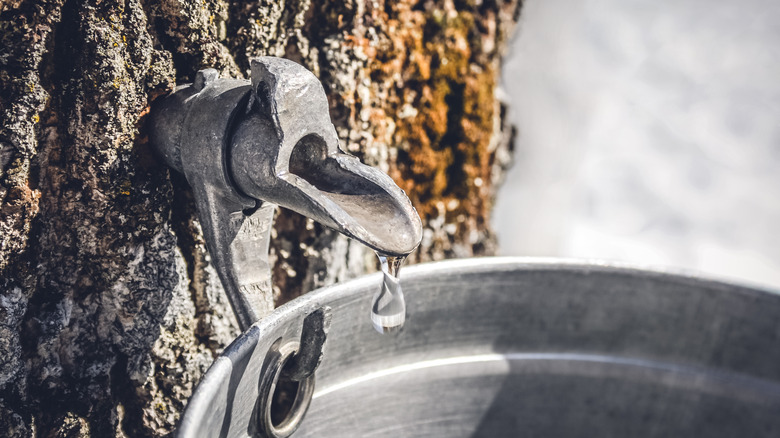The Shady Side Of Maple Syrup
Whether it hails from Canada or New England, maple syrup is often considered no less than the liquid gold of the North American culinary scene. Maple syrup is the condensed sap of the maple tree, and it's delicious not only drizzled over pancakes and waffles, but also stirred into glazes and sauces, shaken into cocktails, or enjoyed plain as candy, like a lollipop.
But despite maple syrup's golden flavor reputation, the industry does indeed have a shadier side. Syrup brands are plagued with echoes of a sometimes pretty questionable past, with issues like colonialism and racism now emerging after years of going somewhat unnoticed by less socially-minded consumers. Today, maple syrup producers are also coming up against environmental woes and the increasing effects of climate change. And of course, there's the sometimes dubious health component of maple syrup to contend with; despite efforts to frame it as an all-natural, healthier alternative to sugar, there are some elements of maple syrup's purported health benefits that barely hold water.
Want the 411 on your favorite pancake topping? We've got all the goss on the true history and modern shady side of maple syrup.
Despite the minerals, maple syrup is basically pure sugar
Health experts sometimes claim that maple syrup is healthier than sugar, agave, or even honey thanks to a wealth of nutrients found in the syrup. And it is admittedly true that maple syrup does indeed have more minerals than other sweeteners, including calcium, potassium, manganese, magnesium, phosphorous, zinc, and iron (via Livestrong). It's also got some phenolic compounds that, according to a 2015 article in Oncology Reports, could indeed lower blood glucose levels and even have an anti-cancer effect. Still, let's not kid ourselves into thinking that this stuff is on the same level as leafy greens or quinoa.
Despite its mineral content, Oncology Reports notes that maple syrup is mainly comprised of sucrose and glucose, which are two different forms of the same thing: sugar. In fact, in 2018, the FDA entertained a controversial regulation that would force maple syrup producers to label their product as containing added sugar due to all that sweetness, though maple syrup is really just the concentrated form of all-natural tree sap. While in 2019, the agency opted not to move forward with the regulation, per FoodDive, the mere idea of it was certainly indicative of the sheer quantity of (yes, natural) sugar in the product.
Now, a little bit of maple syrup is fine, as are most things, in moderation. But seeing as it's usually paired with fat- and carbohydrate-rich pancakes and waffles, maple syrup is far from health food, natural or not.
Most "maple" syrup sold in grocery stores has no maple
Take a close look at the syrup bottles on the shelf in the breakfast aisle of your local grocery, and one thing is for sure: there's a whole lot of syrup for sale that's never even been near a maple tree. While bottles and packaging may well evoke a wistful and nostalgic wintry scene typical of the woodlands of Quebec or Vermont, in reality, these syrups are far removed from the natural maple syrup you know and love.
Most pancake syrup brands (note the careful wording on the labels) are actually made from a combo of corn syrup, high fructose corn syrup, caramel coloring, and preservatives. Food blogger Oh Lardy notes that, out of 42 brands of syrup she found available in her supermarket aisle, about 30 were artificial "maple-flavored" products.
If the artificial stuff is more widely available, it's not just because it's cheaper than the real thing. According to a poll conducted by the Chicago Tribune, it's also overwhelmingly preferred by most American consumers. Given that the taste of truly good maple syrup can easily outshine any example from the sugary and potentially food-dye-loaded competition, that's a real shame.
Fake "maple" syrup is even worse for you
Amongst American consumers, artificial pancake syrup may be generally preferred over real maple syrup, according to one Chicago Tribune poll. But that's far from ideal, considering its sugary nature and rather weak nutritional profile. Indeed, while maple syrup, despite its high sugar content, at least packs some vitamins and minerals into the mix, per Livestrong, maple-less pancake syrup really is just pure sugar. And, frankly, that could be the worst kind for you!
According to MyRecipes, most pancake syrups are made with a combination of corn syrup and high fructose corn syrup, both of which are sweeteners derived from corn. Per the Cleveland Clinic, high fructose corn syrups, in particular, have been linked to myriad health issues including insulin resistance and diabetes. According to a study published in Science, these types of sweeteners may also be associated with an increased risk of colorectal cancer, though researchers noted that a direct link between cancer risk and consumption of high fructose corn syrup hasn't been fully demonstrated.
In short? While maple syrup is far from healthy food, its pancake syrup cousins are just plain bad for you.
Maple syrup production has a history of colonialism
Maple syrup is produced predominantly in the U.S. and Canada. In fact, the Great White North is responsible for a whopping 71 percent of the world's maple syrup production, according to Pure Maple from Canada. But what we don't think about enough is that this product has a culinary heritage, too. And it's not from the European people who settled in Canada, but rather those who were in the Americas long before European settlers arrived.
Some of the earliest post-colonial references to Canadian maple syrup can be found in the 16th and 17th centuries. In these stories, colonists reaped the knowledge of indigenous peoples like the Haudenosaunee and Anishinaabe, all in order to tap local trees and produce maple syrup on their own. Yet, few if any of those folks acknowledged their original native sources, even if they benefited mightily from their learning.
Today, attempts are being made to right this historic wrong and offer, if not reparations, at least recognition of the know-how of First Nations people. According to Capital Current, traditional Indigenous ceremonies are being granted their place in the modern maple syrup production process, for one. Meanwhile, artistic endeavors like 2016's "Oh-Oh Canada" project produce maple candies in the shapes of items connected with colonial violence against First Nations communities like barbed wire, railroad tracks, and nooses, while others in the shapes of human hearts and buffalo highlight Native culture and resistance.
Artificial "maple" syrup has a complicated racial history
In addition to colonialist woes linked to real maple syrup, some brands of pancake syrup have a long and complicated racial history. Both producers and consumers are now grappling with the implications of these brands, their images, and their history. According to Eater, stereotypical "spokescharacters" have long been emblematic of many American brands, from Uncle Ben's rice to Cream of Wheat's Rastus to the syrup and pancake world's Aunt Jemima. These caricatures are problematic for a number of reasons, not the least of which is the propagation of racist stereotypes. In the case of Aunt Jemima — who was a real woman, by the way — the slavery holdout image is that of the Black female caretaker, sometimes reduced to a stock "mammy" image.
Last year, under pressure from growing social and racial justice movements like Black Lives Matter, PepsiCo Inc. announced that it would be removing the image of Aunt Jemima from the brand's packaging. It later announced it would be changing its name to Pearl Milling Company (via NPR).
Meanwhile, the Mrs. Butterworth's pancake syrup brand came under fire from activists, who noted that the human-shaped bottle also evoked the harmful "mammy" stereotype. A spokesperson from Mrs. Butterworth's said in a statement that the bottle shape of this brand of pancake syrup is not meant to evoke a racial stereotype, but rather a "loving grandmother." Conagra Brands nevertheless announced that it will be revisiting its packaging in a comprehensive review.
Maple syrup production takes a lot of energy
Maple syrup brands often rely quite a bit on their all-natural image, aligning themselves with depictions of snowy woods and maple trees where some farming family lovingly tends to their sugary crop. And while we have no qualms about their claims (unless they're trying to sell high fructose corn syrup in a maple-cloaked disguise), there is an unfortunate tendency to overgeneralize maple syrup as also being an environmentally friendly product. And that's unfortunately an ideal that is usually pretty far from reality.
Maple syrup is derived from the natural sap of the maple tree. But that sap doesn't emerge from the tree in the thick, dark, and delicious form it takes in the bottle. According to Sciencing, it takes quite a bit of energy to reduce 800 gallons of maple sap into 20 gallons of maple syrup, with hours of boiling in an evaporator fueled by about 60 gallons of oil or an entire cord of wood. That's about 128 cubic feet of wood, by the way (via The Spruce). That's a lot of non-renewable resources being used to produce your maple syrup, not to mention a fair amount of pollution being released into the air.
While some producers are making moves to use cleaner solutions, such as solar power and reverse osmosis systems, maple syrup is far from the innately green product many brands would have you believe.
Maple syrup is becoming even tougher to make due to climate change
Maple syrup is ever-growing in popularity, with demand for the product experiencing some serious growth recently due to purported health benefits and a surge in at-home baking during the COVID-19 pandemic (via Brand Essence). But maple syrup also joins the host of products being adversely affected by the effects of climate change, including wine, wheat, fish, olive oil, and more.
According to Dartmouth College, climate change doesn't just mean that maple syrup season is coming earlier each year (some experts believe that it may move up by a whole month by 2100). Maple syrup production is also decreasing in many regions, with researchers claiming that states like Virginia and Indiana may "barely be able to produce any sap" by 2100. One 2017 study found that the effects of climate change could mean that five million additional taps would be needed to maintain current U.S. production levels by the end of the century.
It could be that some non-maple trees can produce a maple syrup equivalent, but producers are still facing a real issue that threatens the future of their work. The sad truth may be that genuine maple syrup won't be able to stand up to the increasing effects of climate change on our planet.
Maple syrup is primed for thievery
Perhaps the most baffling tale linked to maple syrup's shadier side is how frequently it becomes a prime target for thieves. Yes, maple syrup is surprisingly primed to become part of a potentially lucrative criminal enterprise. In early 2020, People reports, thieves stole about $150,000 worth of maple syrup in Montreal. And this was nothing compared to a 2012 heist, where thieves made off with a whopping $18 million in emergency reserve syrup (yeah, it's a thing; Canadians really do take their maple syrup very, very seriously) from a warehouse in rural Quebec.
An episode of the Netflix series "Dirty Money" dove deep into the heist, detailing how the government-sanctioned Fédération des producteurs acérioles du Québec, by changing the rules for syrup sale and pricing in Canada, managed to inadvertently create a system that allowed thieves to gain expert knowledge of the syrup reserve system. Said syrup bandits then made off with 9,000 barrels of the stuff, peddled it on the black market, and almost completely eluded detection and capture. And that was all for some of that sweet, sweet maple syrup! Perhaps you'll now want to double-check just where, exactly, you procured that bottle of syrup, just to make sure you're on the right side of the law.
